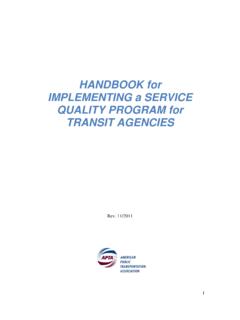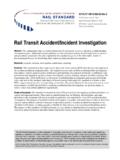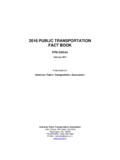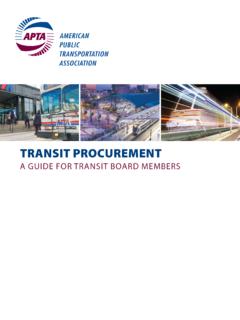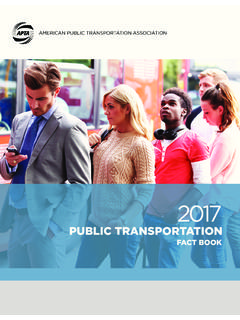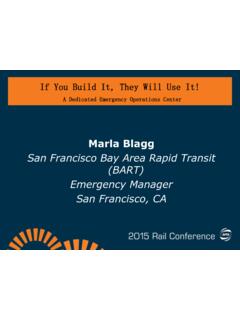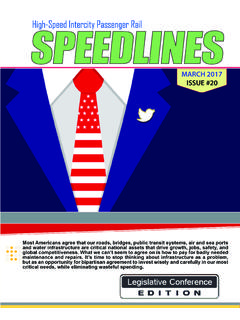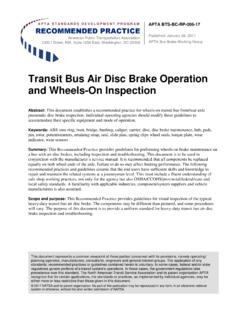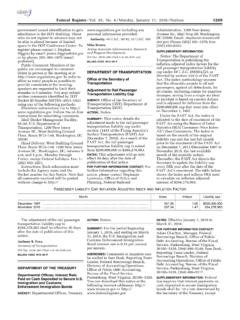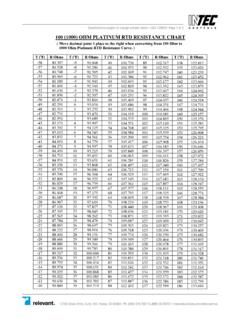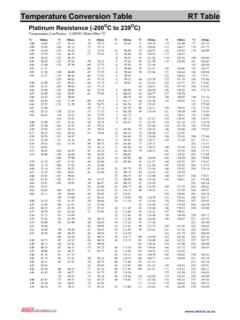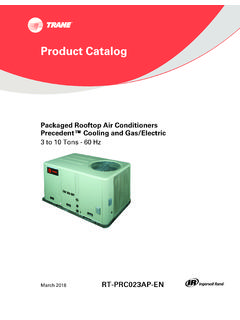Transcription of Rail Transit Fixed Structures Inspection and …
1 A P T A S T A N D A R D S D E V E LO P M E N T P R O G R A M STANDARD American Public Transportation Association 1300 I Street NW, Washington, DC, 20005 APTA RT-FS-S-001-02 Rev 1 First Published September 22, 2002 First Revision October 6, 2016 Rail Transit Fixed Structures Inspection and Maintenance Working Group This Rail Standard represents a common viewpoint of those parties concerned with its provisions, namely, Transit operating/planning agencies, manufacturers, consultants, engineers and general interest groups. The application of any standards, practices or guidelines contained herein is voluntary. In some cases, federal and/or state regulations govern portions of a Transit system s operations. In those cases, the government regulations take precedence over this standard. NATSA (North America Transit Services Association) and its parent organization APTA recognizes that for certain applications, the standards or practices, as implemented by individual Transit agencies, may be either more or less restrictive than those given in this document.
2 2016 NATSA and its parent organization.. No part of this publication may be reproduced in any form, in an electronic retrieval system or otherwise, without the prior written permission of NATSA. Rail Transit Fixed Structures Inspection and Maintenance Abstract: This Rail Standard establishes a standard for inspecting and maintaining rail Transit system Fixed Structures . Keywords: ancillary Structures , barrier walls, bridges, catenary Structures , communication towers, crash walls, culverts, Inspection , maintenance, periodic Inspection and maintenance, retaining walls, safety, Structures , Transit Structures , tunnels. Summary: This standard provides general requirements for the periodic Inspection of safety-critical components of rail Transit Structures . This standard defines the minimum means, methods and frequency of Inspection and maintenance activities, and the qualifications that rail Transit employees or contractors must have to perform these procedures.
3 This standard provides both a rating system for safety-critical components and record-keeping requirements. Scope and purpose: This standard applies to all Fixed facilities that support or carry loads. This includes bridges, tunnels and ancillary Structures ; retaining walls; barrier (crash) walls; communication towers; catenary Structures ; and culverts. This standard applies to rail Transit systems that operate light rail or heavy rail systems. It does not apply to commuter railroads that operate on the general railroad system regulated by the Federal Railroad Administration (FRA). The purpose of this standard is to establish, through broad-based industry participation and consensus, minimum requirements for inspections and maintenance of rail Transit system Structures to ensure the safety of the traveling public and Transit system employees and to ensure the continued performance of rail Transit infrastructure. This standard includes a listing of structure types to be inspected, the frequencies of such inspections, and the qualifications of rail Transit system employees or contractors who perform these Inspection and maintenance activities.
4 2016 American Public Transportation Association | ii Participants The American Public Transportation Association greatly appreciates the contributions of Travis Jones SWG Chair, Clay Bunting, Rich Hovde, Joni Korte, Greg O Hare, Dan Schiffer, and Bong Vang who provided the primary effort in revising this Rail Standard. At the time this standard was completed, the working group included the following members: Greg O Hare, Chair Clay Bunting, Vice Chair Bong Vang, Secretary Carlton Allen Charles Anderson Andrew Baker Ray Blount Brasfield, Steve John Burkhard Steve Brasfield Antonio Cabrera Rob Chappell Arthur Douwes Michael Esford Robert Fiore Holbrook, Michael Brian Hooker Rich Hovde Travis Jones Rick Kindig Jeff King Joni Korte Austin Marshal Michael Monestero Bill Morehead Will Mullet Rotimi Ogunsuyi Phil Olekszyk Al Panuska Balaje Ravichandran Stephen Roberts Carol Rose Mark Rudnicki Dan Schiffer Glenn Shankle Frederick Smith Paul Swanson Pumpane, Corey Steven Thompson Bong Vang Carrie Wagener Quirk, William Contents Introduction.
5 Iii Note on alternate practices .. iii 1. Inspection practices .. 1 Inspection manual .. 1 Condition 1 2. Inspection implementation .. 4 Inspection procedures .. 4 In-depth and fracture critical inspections .. 4 Inspection staff qualifications .. 6 Load rating/scour analysis .. 7 Seismic .. 8 Structural damage diagnosis techniques .. 8 Underwater Inspection .. 8 3. Inspection controls .. 9 Frequency .. 9 Documentation .. 10 4. Maintenance .. 11 Qualifications .. 11 Maintenance Items .. 11 Frequency .. 12 Documentation .. 12 Inspection /maintenance record review .. 12 Related APTA Standards .. 13 References .. 13 Definitions .. 14 Abbreviations and acronyms .. 14 Summary of document changes .. 15 Document 16 Annex A: (informative) - Example of condition rating codes .. 17 Annex B: (informative) - Example of documentation forms .. 18 Project Team Charles Joseph American Public Transportation Association 2016 American Public Transportation Association | iii Introduction This introduction is not a part of APTA RT-FS-S-001-02 First Revision October 6, 2016, Standard for Rail Transit Fixed Structures Inspection and Maintenance.
6 APTA rail Transit safety standards represent an industry consensus on safety practices for rail Transit systems to help achieve a high level of safety for passengers, employees and the general public. This document was created by and for those parties concerned with its provisions, namely, rail Transit systems (operating agencies), manufacturers, consultants, engineers and general interest groups. This standard provides procedures for inspecting and maintaining rail Transit Structures . APTA recommends this standard for the following: individuals or organizations that inspect, maintain and/or operate rail Transit systems individuals or organizations that contract with others for the Inspection , maintenance and/or operation of rail Transit systems individuals or organizations that influence how rail Transit systems are inspected, maintained and/or operated (including but not limited to consultants, designers and contractors) This standard intends to meet the following objectives: to ensure that special life/safety equipment is operational and reliable to help rail Transit systems incorporate safety considerations during the Inspection and maintenance process to identify Inspection criteria and maintenance standards that provide a high level of passenger and personnel safety.
7 Note on alternate practices Individual rail Transit systems may modify the practices in this standard to accommodate their specific equipment and mode of operation. APTA recognizes that some rail Transit systems may have unique operating environments that make strict compliance with every provision of this standard impossible. As a result, certain rail Transit systems may need to implement the standards and practices herein in ways that are more or less restrictive than this document prescribes. A rail Transit system may develop alternates to APTA standards provided the alternates are based on a safe operating history and are described and documented in the system s safety program plan (or another document that is referenced in the system safety program plan). Documentation of alternate practices shall: Identify the specific APTA rail Transit safety standard requirements that cannot be met. Provide justification for each requirement that cannot be followed.
8 Describe the alternate methods used. Describe and substantiate how the alternate methods do not compromise safety and provide a level of safety equivalent to the practices in the APTA safety standard (operating histories or hazard analysis findings may be used to substantiate this claim). APTA RT-FS-S-001-02 Rev. 1 Rail Transit Fixed Structures Inspection and Maintenance 2016 American Public Transportation Association Page 1 of 28 Rail Transit Structure Inspection and Maintenance This APTA standard has been established to provide general minimum requirements for Transit agencies for inspecting and maintaining all Fixed facility Structures supporting rail Transit system loads. This standard covers general Inspection practices, Inspection staff qualifications, Inspection types and frequencies, and maintenance practices. 1. Inspection practices Inspection manual Rail Transit systems shall develop or formally adopt existing structural Inspection manuals with the following sections: a) Inspection and Maintenance Organization Job descriptions Qualifications Responsibilities b) Policies Personnel Inspection Maintenance Safety Reports, plans and files c) Coordination Internal interfaces External interfaces d) Quality assurance/quality control e) Inspection procedures f) Planning and scheduling g) Inventory h) Inspection type i) Documentation COMMENT: Each rail Transit system shall obtain Inspection manuals used by the state(s) in which it operates.
9 These are necessary for inspecting/documenting highway grade separations that the rail Transit system may own or maintain. A rail Transit system with bridges that are regulated by FRA shall also ensure that their Bridge Safety Management Program conforms in accordance with 49 CFR part 237. Transit Authorities are encouraged to verify if owners of overhead Structures are inspecting and maintaining their overhead Structures in accordance with the applicable laws and regulations. This is necessary for rail Transit owners to assure a safe operating environment. Condition ratings Each Transit system shall establish or formally adopt, a rating system pertaining to its Structures that is both compatible with its maintenance planning and scheduling and with any outside agencies it must coordinate APTA RT-FS-S-001-02 Rev. 1 Rail Transit Fixed Structures Inspection and Maintenance 2016 American Public Transportation Association Page 2 of 28 with.
10 If it has a computerized maintenance system, then the rating system must be structured to input into that system. The inspectors must be trained to uniformly apply the rating system when performing the inspections. The rating system, at a minimum, shall cover the Structures and components listed in Section through Section Agencies are encouraged to augment the rating system as necessary to complement their infrastructure inventory. Bridges a) Substructure: Material: o Timber o Concrete (cast in place/precast) o Masonry o Steel Other: o Slope protection o Coating System b) Superstructure Type: o Truss o Multi-girder o Box girder o Arches o Slab o Movable o Rigid frame o Suspension o Cable stayed Material: o Steel o Timber o Concrete (cast in place/precast) o Pre-stressed concrete o Masonry Other: o Bearings Coating system o Special connections (pin-hangers) c) Decks Material: o Concrete (cast in place/precast) o Steel o Timber: - Parapets - Railings - Walkways - Appendages Other: APTA RT-FS-S-001-02 Rev.
